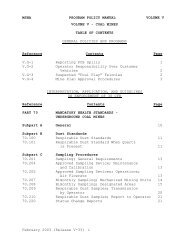MSHA HANDBOOK SERIES - PH13-V-1 - Mine Safety and Health ...
MSHA HANDBOOK SERIES - PH13-V-1 - Mine Safety and Health ...
MSHA HANDBOOK SERIES - PH13-V-1 - Mine Safety and Health ...
You also want an ePaper? Increase the reach of your titles
YUMPU automatically turns print PDFs into web optimized ePapers that Google loves.
GENERAL COAL MINE INSPECTION PROCEDURES AND<br />
INSPECTION TRACKING SYSTEM <strong>HANDBOOK</strong> CHAPTER 4<br />
provided off-site. Persons not allowed at the mine site should include: reporters,<br />
photographers, spectators, friends, curiosity seekers, <strong>and</strong> others not necessary to a safe<br />
<strong>and</strong> orderly emergency operation.<br />
Access to underground areas of the mine is further restricted. Underground access<br />
should be restricted to only mine employees <strong>and</strong> contractors, state <strong>and</strong> federal mining<br />
officials, labor representatives, mine rescue teams, necessary consultants, <strong>and</strong> any<br />
others, only if approved on a case-by-case basis following consultation with<br />
Headquarters. No person should be allowed underground unless necessary to the<br />
safe <strong>and</strong> timely rescue or recovery efforts.<br />
Section 103(j) <strong>and</strong> 103(k)<br />
The term “accident” is defined in Section 3(k) of the <strong>Mine</strong> Act. Generally, the District<br />
Manager or District Accident Investigation Coordinator will determine which<br />
accidents will be investigated. On learning of an accident, unless <strong>MSHA</strong> is already<br />
present, enforcement personnel should verbally issue a Section 103(j) order to the<br />
operator, including initial instructions, as soon as possible. The order, including any<br />
instructions, should then be reduced to writing <strong>and</strong> transmitted to the operator as soon<br />
as practicable.<br />
The order should also require the operator to prevent the destruction of evidence at<br />
the accident site. In the event that a mine accident is not a mine emergency (i.e., there<br />
are no ongoing rescue <strong>and</strong> recovery efforts), <strong>MSHA</strong> may issue a 103(j) order<br />
prohibiting activity at the accident site to prevent the destruction of evidence which<br />
would assist in investigating the cause or causes of the accident.<br />
On <strong>MSHA</strong>’s arrival on site <strong>and</strong> following assessment of conditions, <strong>MSHA</strong> may<br />
modify the Section 103(j) order, including all instructions, to reflect that <strong>MSHA</strong> is now<br />
proceeding under the authority of Section 103(k) of the <strong>Mine</strong> Act. <strong>MSHA</strong> should<br />
inform parties on site that any activities that are rescue or recovery related will be<br />
permitted through subsequent modifications of the Section 103(k) order. The Section<br />
103(k) order is intended to protect all persons involved in the emergency operation or<br />
accident investigation. As such, all parties on site are subject to the Section 103(k)<br />
order <strong>and</strong> any subsequent modifications. Each proposed action should be reviewed by<br />
the designated <strong>MSHA</strong> person onsite before the Section 103(k) order is modified <strong>and</strong><br />
before the action is commenced. <strong>MSHA</strong> has the authority to issue a Section 103(k)<br />
order unilaterally. However, every effort should be made to gain consensus among<br />
the parties involved to obtain the safest <strong>and</strong> most effective outcome. (Refer to 103(j)<br />
Sample Language for further guidance.)<br />
Release 1 (February 2013) 4-25
















